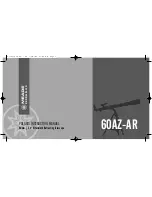
Let your eyes “dark-adapt:” Allow five or
ten minutes for your eyes to become “dark
adapted” before observing. Use a red-
filtered flashlight to protect your night vision
when reading star maps, or inspecting the
telescope. Do not use use a regular flash-
light or turn on other lights when observing
with a group of other astronomers. You can
make your own red filtered flashlight by
taping red cellophane over a flashlight lens.
Viewing through windows: Avoid setting up
the telescope inside a room and observing
through an opened or closed window pane.
Images may appear blurred or distorted due
to temperature differences between inside
and outside air. Also, it is a good idea to
allow your telescope to reach the ambient
(surrounding) outside temperature before
starting an observing session.
When to observe: Planets and other objects
viewed low on the horizon often lack sharp-
ness—the same object, when observed
higher in the sky, will appear sharper and
have greater contrast. Try reducing power
(change your eyepiece) if your image is fuzzy
or shimmers. Keep in mind that a bright,
clear, but smaller image is more interesting
than a larger, dimmer, fuzzy one. Using too
high a power eyepiece is one of the most
common mistakes made by new
astronomers.
Dress Warm: Even on summer nights, the
air can feel cool or cold as the night wears
on. It is important to dress warm or to have
a sweater, jacket, gloves, etc., nearby.
Know your observing site: If possible, know
the location where you will be observing. Pay
attention to holes in the ground and other
obstacles. Is it a location where wild
animals, such as skunks, snakes, etc., may
appear? Are there viewing obstructions
such as tall trees, street lights, headlights
and so forth? The best locations are dark
locations, the darker the better. Deep space
objects are easiest to see under dark skies.
But it is still possible to observe even in a city.
Surf the Web and visit your local library:
The internet contains a huge amount of
astronomical information, both for children
and adults. Check out astronomy books from
your library. Look for star charts—these are
available on a monthly basis in
Astronomy
and
Sky and Telescope magazines.
ASTRONOMY RESOURCES
•
The Meade 4M Community
6001 Oak Canyon, Irvine, CA 92618
•
Astronomical League
Executive Secretary
5675 Real del Norte, Las Cruces, NM 88012
•
The Astronomical Society of the Pacific
390 Ashton Ave., San Francisco, CA 94112
•
The Planetary Society
65 North Catalina Ave, Pasadena, CA 91106
•
International Dark-Sky Association, Inc.
3225 N. First Avenue, Tucson, AZ 85719-2103
HAVE A GOOD TIME,
ASTRONOMY IS FUN!
SPECIFICATIONS
Optical tube focal length . . 700mm
Objective lens diameter. . . 60mm (2.4")
Focal ratio. . . . . . . . . . . . . . f/11.7
Mounting type. . . . . . . . . . . Altazimuth
11
Polaris 60 AZ - AR 3/10/06 11:48 AM Page 13































